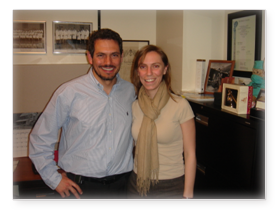|
INTERVIEW TO A. PIGAZZI (City of Hope, LA, USA) R. Jiménez Rodriguez
Along 2009 January and February, I had the opportunity of visiting the City of Hope Hospital (Duarte, California), where thanks to Dr. García Aguilar, Chief of Surgical Department, I met to Dr. Alessio Pigazzi, Chief of Minimally Invasive Surgery Unit, who is specially engaged to robot-assisted surgery and who is one of the most productive surgeons in the field of digestive surgery robot applications. As a result of this visit, Dr. Pigazzi came to Sevilla last May and this friendly relationship has provided us occasion to interview him to learn of his experience.
R.M.J. After getting your Medical Degree in Boston University, you completed your surgical residency in the New York Presbyterian Hospital and then you did a bariatric and robotic surgery Fellowship in New Jersey. ¿Why did you decide to get training in robot-assisted surgery?
A.P. I became interested in robotic surgery during my year in New Jersey with Garth Ballantyne who was doing some selected procedures in general surgery using the robot. Subsequently, I had the opportunity to spend some time with Piero Giulianotti in Italy and saw some highly sophisticated applications of robotic surgery in surgical oncology. This stimulated me to do more upon taking my position at City of Hope in 2004.
R.M.J. In 2001, the FDA approved clinical use of Da Vinci system to digestive procedures. Eight years later, ¿how does robotic surgery performance in USA large hospitals?
A.P. In most large centers, robotic surgery has become the standard of care for radical prostatectomy. There is also a growing use in gynecologic oncology. In general surgery only a few centers are routinely performing robotic procedures. Most of the interest is around robotic rectal surgery which we pioneered five years ago.
R.M.J. Do you think Digestive Surgery could reach important clinical benefit from robotics, as do nowadays Urology or Gynecology?
A.P. Given the prevalence of the disease and the suitability to robotic applications, there is no doubt that robotic prostatectomy will be the most frequently performed robotic procedures in the next few years. But I think that other fields will gain tremendously from robotic technology over time.
R.M.J. Why do you use Da Vinci mainly in rectal cancer resection? What do you think of other applications in colorectal surgery, as sigmoid, right colectomy and benign diseases?
A.P. We have found the greatest benefits of robotics when dealing with rectal cancer, mostly because the visualization and the retraction are superior to what we can achieve with conventional laparoscopy in mid and low tumors. We do perform some segmental colectomies with the robot but frankly I don’t see a great advantage there. We are very comfortable with laparoscopic colon resection and this represents our main technique for anything higher than 10 centimeters.
R.M.J. ¿Which are the more frequent robotic procedures in your institution?
A.P. All rectal resections requiring total mesorectal excision (TME) and gastrectomies requiring extended lymphadenectomies are our most frequent uses of the robot.
R.M.J. In rectal cancer you apply conventional laparoscopy to mobilize the splenic angle. In the same way, you use to start oncologic gastrectomy by laparoscopic tradicional approach, ¿which are the advantages of these hibrid procedures?
A.P. The greatest advantage is that by using conventional laparoscopy we can utilize gravity by moving the table from Trendelenburg position to reverse Trendelenburg as needed. With the robot it is not possible to move the patient and so this advantage is lost. So I think the hybrid operation ends up actually being easier than a fully robotic one. That is why I firmly believe that it is important to be accomplished laparoscopic surgeons before starting to perform advanced robotic procedures.
R.M.J. Do you still perform any open mesorectal excision? And by tradicional laparoscopic approach (no robotics)?
A.P. Yes I usually perform open surgery in case of recurrent cancers or tumors requiring pelvic exenteration. I perform laparoscopic TME if the robot is not available (which happens very rarely) or if I am dealing with a female patient with a low BMI and a tumor higher than 9-10 cm.
R.M.J. Do you select anyway patients to perform any robotic technique?
A.P. No. We have never selected patients and have operated on BMI as high as 44 and on patients with big prior abdominal operations.
R.M.J. In 2008 a consensus document (MIRA-SAGES) was published stating the requirements one surgeon must fulfil to be able to manage a robotic system. What do you think about robotic surgeon training?
A.P. I think that good training -like for any other new technique- is very important. Too many surgeons think the robotic does it by itself and nothing is farther from the truth. First, a surgeon should know how to do the open operation very well. Second, he or she should be an experienced conventional laparoscopic surgeon because laparoscopic techniques are fundamental in most operation in general surgery. This requirement may change as newer and better robot become available but at this time very few inexperienced laparoscopic surgeon will become highly effective robotic operators in general and surgical oncology.
R.M.J. Did you have previous laparoscopic surgery training before using the robot?
A.P. I performed over 500 advanced laparoscopic procedures before starting to perform advanced robotic operations.
R.M.J. We know in your Hospital there are no residents, but there are fellows in the Surgical Department, when do they start robotic training? Do they perform specific robotic courses?
A.P. All our fellows do the basic training in robotic surgery and transition from being robotic assistants to robotic surgeons over two training years of depending on the individual interests and skills.
R.M.J. Regarding to NOTES and MA-NOS surgery, do you believe robotic surgery may contribute to develop these approaches?
A.P. Yes, new robot will undoubtedly help make natural orifice surgery a reality in the future.
R.M.J. Probably one of the largest disadvantages of Da Vinci system is its cost. According to you, is it justified to assume this high cost to apply robotic techniques in any kind of procedure, even if their clinical advantages are not proven?
A.P. It is difficult to justify the additional costs without proven benefits. That’s why rigorous studies are necessary.
R.M.J. Do you consider more comercial competivity to break current monopole of surgical robotic industry could reduce costs?
A.P. Competition is always good.
R.M.J. How do you see the future of robotic surgery? Will surgeons collaborate with industry and engineering to develop better robotic systems?
A.P. I think the future will bring more and more robotic procedures as robots become simpler and cheaper. The current robots were developed with the input of surgeons and this role will continue in the future.
R.M.J. We gratefully thank to Dr. Pigazzi his collaboration with SECLAEndosurgery, and we hope his experience and opinions may be interesting to all our readers. 

|








